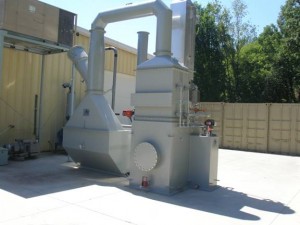Problem:
Actually, a lot of smoke is generated at this northeastern fire test facility, which is used to determine the effectiveness of their various dry powder extinguisher media. Liquid hydrocarbons ranging from gasoline to kerosene are ignited on the floor and allowed to develop into a full-fledged fire before extinguishment. After each test, the smoke must be cleared from the 216,000 ft3 burn room in 1 hour or less to allow timely set-up of the next test. However, the smoke could not simply be exhausted out to the atmosphere due to the near proximity of residential neighborhoods with the potential for nuisance odors as well as an eye sore. More formally, the exhaust would have to comply with U.S. EPA’s limit of 20% stack opacity. Even this might leave too much room for complaints by the public, who were generally very cautious about such a process coming into the neighborhood.
Many factors combined to make this a very challenging air clean-up application: smoke particles and aerosols are submicron; these and other airborne pollutants generated during fire testing are not very soluble in water, and even less so at the elevated temperature of the combustion test room exhaust; and the high-profile, political nature of the installation obligated the design to over-perform, lest it not hold up to the hypercritical eye of the concerned public. Because the submicron smoke particles are so tiny, they lack inertia and therefore cannot be collected at high efficiency by conventional methods of inertial impaction. Conversely, filtration, which can separate submicron particles from an airstream, would result in rapid clogging of filters due to high loads and oily nature of the smoke.
Solution:
Late in 2011, an AAT, Inc. multi-stage Orion smoke particulate scrubber was installed due to its unique engineering considerations and design features. The multiple stages consisted of a direct contact spray cooler, wet venturi air scrubber, and HEPA filtration unit. The use of a bank of HEPA filters provided assurance of a clear stack but also required effective pre-scrubbing in the upstream venturi. Otherwise, filter replacement would be a serious drawback, both in terms of maintenance and operating costs. Along the same lines, because the air exiting the wet venturi air scrubber has 100% Relative Humidity, water would condense in the HEPAs, saturating and ruining them prematurely. To prevent this, a small volume rate of room air is heated in an electric heater and blended with the Orion wet scrubber exhaust air prior to entering the HEPAs.
Pre-scrubbing of smoke particulates and aerosols was maximized in the wet venturi scrubber. This air scrubber was designed for nearly complete removal by inertial impaction of >1 micron particles. Removal of submicron particles was enhanced by taking advantage of a process known as thermophoresis. To do this, the length of collection duct for the hot combustion products needed to be as short and well-insulated as possible, so as to prevent cooling and condensation of high boiling pollutants such as tars and oils in the ductwork. Not only does this prevent eventual clogging of the duct but it also prevents formation of additional submicron particles. These condensable vapors instead collect as liquid condensate on the surfaces of the cold water droplets in the direct contact spray cooler. Because of the high vapor flux near the surfaces of the cold water droplets, submicron particles become entrained in this flow and also collect on the droplet surfaces. The thermophoretic force of the vapor molecules “push” the smoke particles toward the droplets.

Air scrubber system accessories and ancillaries included interconnecting ductwork and piping, exhaust fan, exhaust stack, full complement of instrumentation, and AAT, Inc. designed and built control panel. A unique accessory on this project was a Continuous Emissions Monitor (CEM) for Carbon Monoxide (CO) installed in the exhaust stack in order to facilitate demonstration of compliance with U.S. EPA regulation limiting CO emissions.
Customer feedback has been very positive. The net result of this unique and elaborate air scrubber system is that it meets all the challenges inherent to this difficult application, producing a clear stack with original HEPA filters still installed even after months of operation. According to the customer, this particulate air scrubber system “worked like a charm” when recently put to the test on a fuel that forms particularly oily smoke.


